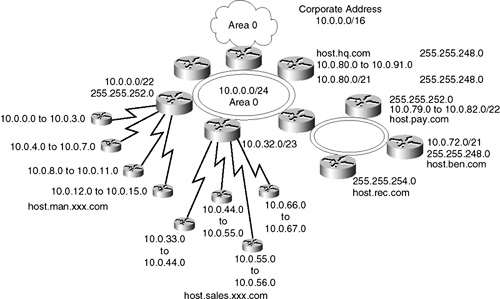Designing Implementing an OSPF Network
Example of an OSPF Network with a Hierarchical Structure To design this type of model network, you should gather a list of the different locations requiring network connectivity within your organization. For purposes of this example and ease of understanding, let’s consider your organization, as an international corporation, and you have been tasked with building its OSPF network within the United States. You have determined that you have the following divisions (each with various business units within it), as shown in the following hierarchy, which groups the units by location and then by function.
The listed units will become the basis of OSPF areas. Contained within the areas will be OSPF inter-area routers that connect to the various hosts. Of these groupings, you should select essential locations at which to locate the backbone routers. For our example, you know that Headquarters will have a backbone router that will be connected to area 0. You have been given several requirements based upon traffic flow and corporate requirements:
Begin separating the sites into areas and picking one location within each area at which will reside the area border router (ABR). This will result in a proposed set of OSPF routers deployed as follows:
The remaining sites will each be assigned an inter-area router to connect them to the network. One main site within each geographical area will be the hub site for that geographic area, thereby reducing bandwidth costs. At this point, you should have your organization separated into areas or layers and an overall topology map laid out. Figure 7-10 illustrates the example network described up to this point.
I want to throw out a couple of disclaimers here before people start tearing up my example. First, remember requirement number 1 (All divisions must be within the same area, regardless of geographic location). Second, there are many ways of designing a network and this is just one way and one person’s opinion. Third, there is no substitute for actual network design experience, because everyone makes mistakes. Fourth, now that you think you have a solid network design, have someone else look at it and consider modeling it in a software package such as NetSys from Cisco. Step 3: Determine Addressing & Naming Conventions Step 3 covers the actual process of assigning the overall network-addressing scheme. By assigning blocks of addresses to portions of the network, you are able to simplify addressing, administration, routing and increase scalability. Because OSPF supports variable-length subnet masking (VLSM), you can really develop a true hierarchical addressing scheme. This hierarchical addressing results in very efficient summarization of routes throughout the network. VLSM and CIDR were discussed at great length earlier in the book, and it is in this step of designing your OSPF network that you should begin applying these two techniques.
Public or Private Address Space A good rule of thumb to remember when determining whether to use public or private address space is that your address scheme must be able to scale enough to support a larger network because your network will most likely continue to grow. Now you must determine what range of IP addresses you are going to deploy within your network. The first question you need to answer is: “Do I have public address space assigned to me by the InterNIC or am I going to be using private address space as specified in RFC 1918 and 1597?” Either choice will have its implications on the design of your network. By choosing to use private address space and with having to connect to the Internet, you will be faced with having to include the capability to do address translation as part of your network design. To further complicate the issue, you might also have to deal with a preexisting addressing scheme and/or the need to support automatic address assignment through the use of Dynamic Host Configuration Protocol (DHCP) or Domain Naming System (DNS). That type of technology is beyond the scope of this book and will not be covered.
|
EAN: 2147483647
Pages: 200

